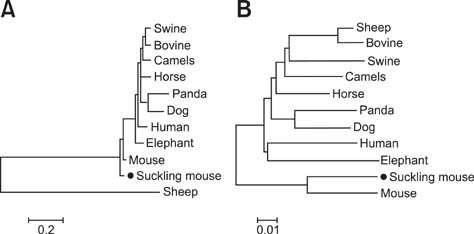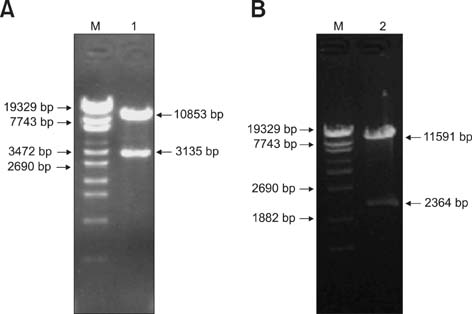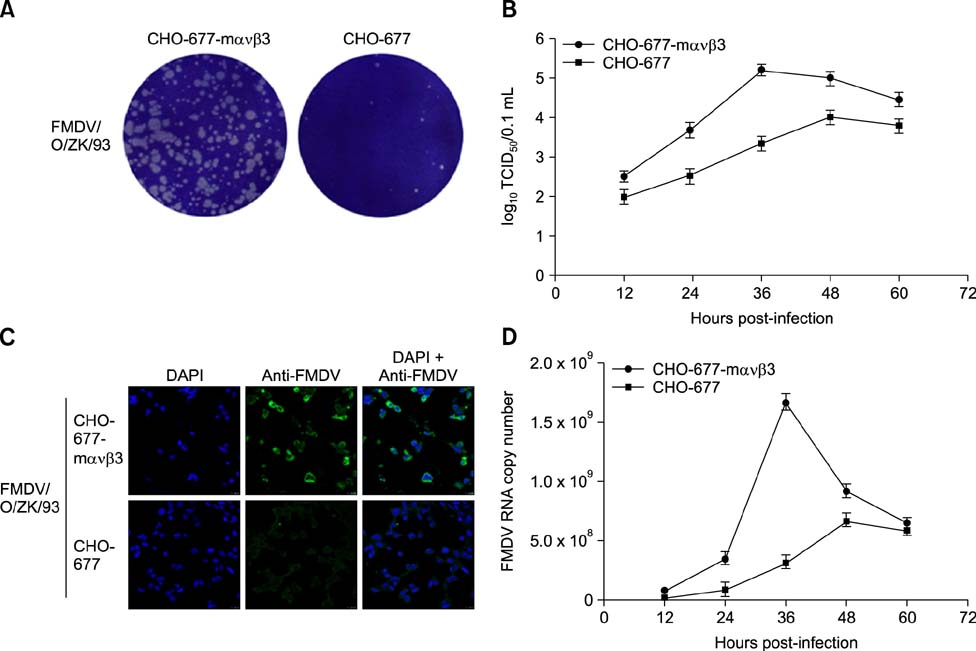J Vet Sci.
2015 Sep;16(3):265-272. 10.4142/jvs.2015.16.3.265.
Establishment and evaluation of a murine alphavbeta3-integrin-expressing cell line with increased susceptibility to Foot-and-mouth disease virus
- Affiliations
-
- 1State Key Laboratory of Veterinary Etiological Biology, National Foot-and-Mouth Disease Reference Laboratory, Key Laboratory of Animal Virology of Ministry of Agriculture, Lanzhou Veterinary Research Institute, Chinese Academy of Agricultural Sciences, La
- KMID: 2344298
- DOI: http://doi.org/10.4142/jvs.2015.16.3.265
Abstract
- Integrin alphavbeta3 plays a major role in various signaling pathways, cell apoptosis, and tumor angiogenesis. To examine the functions and roles of alphavbeta3 integrin, a stable CHO-677 cell line expressing the murine alphavbeta3 heterodimer (designated as "CHO-677-malphavbeta3" cells) was established using a highly efficient lentiviral-mediated gene transfer technique. Integrin subunits alphav and beta3 were detected at the gene and protein levels by polymerase chain reaction (PCR) and indirect immunofluorescent assay (IFA), respectively, in the CHO-677-malphavbeta3 cell line at the 20th passage, implying that these genes were successfully introduced into the CHO-677 cells and expressed stably. A plaque-forming assay, 50% tissue culture infective dose (TCID50), real-time quantitative reverse transcription-PCR, and IFA were used to detect the replication levels of Foot-and-mouth disease virus (FMDV) in the CHO-677-malphavbeta3 cell line. After infection with FMDV/O/ZK/93, the cell line showed a significant increase in viral RNA and protein compared with CHO-677 cells. These findings suggest that we successfully established a stable alphavbeta3-receptor-expressing cell line with increased susceptibility to FMDV. This cell line will be very useful for further investigation of alphavbeta3 integrin, and as a cell model for FMDV research.
Keyword
MeSH Terms
Figure
Reference
-
1. Akers WJ, Zhang Z, Berezin M, Ye Y, Agee A, Guo K, Fuhrhop RW, Wickline SA, Lanza GM, Achilefu S. Targeting of αvβ3-integrins expressed on tumor tissue and neovasculature using fluorescent small molecules and nanoparticles. Nanomedicine (Lond). 2010; 5:715–726.
Article2. Argraves WS, Pytela R, Suzuki S, Millán JL, Pierschbacher MD, Ruoslahti E. cDNA sequences from the α subunit of the fibronectin receptor predict a transmembrane domain and a short cytoplasmic peptide. J Biol Chem. 1986; 261:12922–12924.
Article3. Banasik MB, McCray PB Jr. Integrase-defective lentiviral vectors: progress and applications. Gene Ther. 2010; 17:150–157.
Article4. Berman AE, Kozlova NI. Integrins: structure and functions. Membr Cell Biol. 2000; 13:207–244.5. Brooks PC, Montgomery AMP, Rosenfeld M, Reisfeld RA, Hu T, Klier G, Cheresh DA. Integrin αvβ3 antagonists promote tumor regression by inducing apoptosis of angiogenic blood vessels. Cell. 1994; 79:1157–1164.
Article6. Clark RA, Tonnesen MG, Gailit J, Cheresh DA. Transient functional expression of αvβ3 on vascular cells during wound repair. Am J Pathol. 1996; 148:1407–1421.7. Coffin JM, Hughes SH, Varmus HE. The Interactions of Retroviruses and their Hosts. In : Coffin JM, Hughes SH, Varmus HE, editors. Retroviruses. New York: Cold Spring Harbor Laboratory Press;1997.8. Desgrosellier JS, Cheresh DA. Integrins in cancer: biological implications and therapeutic opportunities. Nat Rev Cancer. 2010; 10:9–22.
Article9. Domingo E, Baranowski E, Escarmís C, Sobrino F. Foot-and-mouth disease virus. Comp Immunol Microbiol Infect Dis. 2002; 25:297–308.
Article10. Gu YX, Gao ZL, Zhou JH, Zhang J, Liu YS. Establishment and evaluation of stable cell lines inhibiting foot-and-mouth disease virus by RNA interference. Biomed Res Int. 2014; 2014:109428.
Article11. Hegde S, Raghavan S. A skin-depth analysis of integrins: role of the integrin network in health and disease. Cell Commun Adhes. 2013; 20:155–169.
Article12. Humphries MJ. Integrin structure. Biochem Soc Trans. 2000; 28:311–339.
Article13. Hussain AF, Tur MK, Barth S. An aptamer-siRNA chimera silences the eukaryotic elongation factor 2 gene and induces apoptosis in cancers expressing αvβ3 integrin. Nucleic Acid Ther. 2013; 23:203–212.
Article14. Hynes RO. Integrins: bidirectional, allosteric signaling machines. Cell. 2002; 110:673–687.15. Isberg RR, Tran Van Nhieu G. Binding and internalization of microorganisms by integrin receptors. Trends Microbiol. 1994; 2:10–14.
Article16. Liu S, Calderwood DA, Ginsberg MH. Integrin cytoplasmic domain-binding proteins. J Cell Sci. 2000; 113:3563–3571.
Article17. Ma X, Li P, Bai X, Sun P, Bao H, Lu Z, Cao Y, Li D, Chen Y, Qiao Z, Liu Z. Sequences outside that of residues 93-102 of 3A protein can contribute to the ability of foot-and-mouth disease virus (FMDV) to replicate in bovine-derived cells. Virus Res. 2014; 191:161–171.
Article18. Miller LC, Blakemore W, Sheppard D, Atakilit A, King AM, Jackson T. Role of the cytoplasmic domain of the β-subunit of integrin αvβ6 in infection by foot-and-mouth disease virus. J Virol. 2001; 75:4158–4164.
Article19. Neff S, Baxt B. The ability of integrin αvβ3 to function as a receptor for foot-and-mouth disease virus is not dependent on the presence of complete subunit cytoplasmic domains. J Virol. 2001; 75:527–532.
Article20. Neff S, Sá-Carvalho D, Rieder E, Mason PW, Blystone SD, Brown EJ, Baxt B. Foot-and-mouth disease virus virulent for cattle utilizes the integrin αvβ3 as its receptor. J Virol. 1998; 72:3587–3594.
Article21. Plow EF, Haas TA, Zhang L, Loftus J, Smith JW. Ligand binding to integrins. J Biol Chem. 2000; 275:21785–21788.
Article22. Pytela R, Pierschbacher MD, Ruoslahti E. A 125/115-kDa cell surface receptor specific for vitronectin interacts with the arginine-glycine-aspartic acid adhesion sequence derived from fibronectin. Proc Natl Acad Sci U S A. 1985; 82:5766–5770.
Article23. Pytela R, Pierschbacher MD, Ruoslahti E. Identification and isolation of a 140 kd cell surface glycoprotein with properties expected of a fibronectin receptor. Cell. 1985; 40:191–198.
Article24. Ruoslahti E, Pierschbacher MD. Arg-Gly-Asp: a versatile cell recognition signal. Cell. 1986; 44:517–518.
Article25. Stupack DG, Cheresh DA. ECM remodeling regulates angiogenesis: endothelial integrins look for new ligands. Sci STKE. 2002; 2002:pe7.
Article26. Stupack DG, Puente XS, Boutsaboualoy S, Storgard CM, Cheresh DA. Apoptosis of adherent cells by recruitment of caspase-8 to unligated integrins. J Cell Biol. 2001; 155:459–470.
Article27. Tamura K, Peterson D, Peterson N, Stecher G, Nei M, Kumar S. MEGA5: molecular evolutionary genetics analysis using maximum likelihood, evolutionary distance, and maximum parsimony methods. Mol Biol Evol. 2011; 28:2731–2739.
Article28. van der Flier A, Sonnenberg A. Function and interactions of integrins. Cell Tissue Res. 2001; 305:285–298.
Article29. Zhang Y, Zheng HX, Zhang ZD, Jin Y, Yang F, He JJ, Cao WJ, Sun DH, Lv L. Establishment of a murine αvβ1 transgenic CHO-K1 cell line and its susceptibility to foot-and-mouth disease virus type Asia I/HN/2006 in China. J Anim Vet Adv. 2013; 12:108–117.30. Zhang Y, Sun Y, Yang F, Guo J, He J, Wu Q, Cao W, Lv L, Zheng H, Zhang Z. Induction of partial protection against foot and mouth disease virus in guinea pigs by neutralization with the integrin β6-1 subunit. Viruses. 2013; 5:1114–1130.
Article31. Zhao H, Ross FP, Teitelbaum SL. Unoccupied αvβ3integrin regulates osteoclast apoptosis by transmitting a positive death signal. Mol Endocrinol. 2005; 19:771–780.
Article
- Full Text Links
- Actions
-
Cited
- CITED
-
- Close
- Share
- Similar articles
-
- Stable Expression of Bovine Integrin Beta-6 Increases Susceptibility of Goat Kidney Cell Line to Foot-and-mouth Disease Virus
- Integrin alphavbeta3, alpha5beta1 Effects on Cell Proliferation and Migration in Human Osteosarcoma
- T-CAM, a fastatin-FIII 9-10 fusion protein, potently enhances anti-angiogenic and anti-tumor activity via alphavbeta3 and alpha5beta1 integrins
- Invasiveness of and Drug Sensitivity to Various Anti-cancer Regimens in Five Colorectal Cancer Cell Lines
- Isolation of Echovirus Serotype 25 from Patient with Hand , Foot and Mouth Disease in Pusan , 1998







